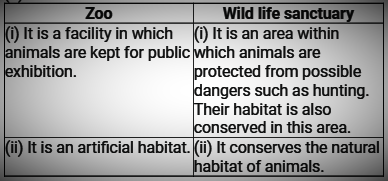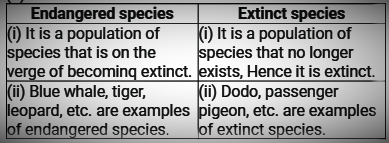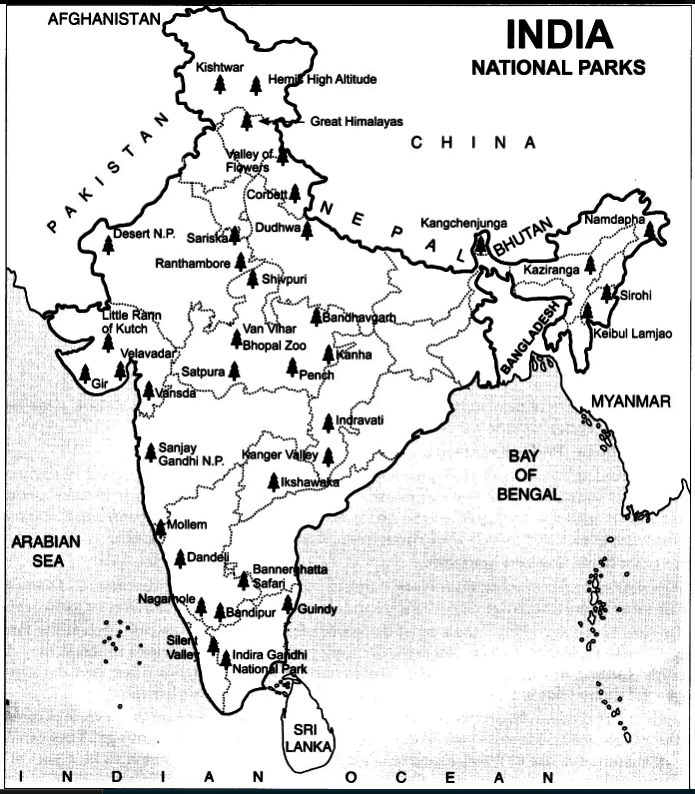GetStudySolution
Getstudysolution is an online educational platform that allows students to access quality educational services and study materials at no cost.
NCERT Solutions for Class 8 Science chapter 7 – Conservation of Plants and Animals
Back Exercise
Question 1:
Fill in the blanks.
(a) A place where animals are protected in their natural habitat is
called __________.
(b) Species found only in a particular area is known as __________.
(c) Migratory birds fly to far away places because of __________ changes.
Answers
(a) Sanctuary
(b) Endemic
(c) Climatic
Question 2:
Differentiate between the following.
(a) Wildlife sanctuary and biosphere reserve
(b) Zoo and wildlife sanctuary
(c) Endangered and extinct species
(d) Flora and fauna
Answers
(a) 
(b) 
(c) 
(d) 
Question 3:
Discuss the effects of deforestation on the following.
(a) Wild animals
(b) Environment
(c) Villages (Rural areas)
(d) Cities (Urban areas)
(e) Earth
(f) The next generation
(a) Effects of deforestation on wild animals:
Removal of trees and plant life from a particular area for the construction of industries, agriculture or for other such purposes is termed as Deforestation. Plant life forms an integral part of the ecosystem and these plants form the natural habitat of various animals of that ecosystem. Destroying the plant life will ultimately threaten the existence of animals in that particular ecosystem and may lead to their extinction.
(b) Effects of deforestation on the environment:
In plants, Photosynthesis takes place by the absorption of CO2 from the earth’s atmosphere. The percentage of CO2 in the atmosphere increases rapidly if the plant life of an area is destroyed. Increased concentrations of CO2 result in the trapping of excessive heat radiations within the Earth’s atmosphere contributing to global warming. This results in the rise of the temperature of the Earth and disturbs the water cycle which occurs in nature. Hence, rainfall pattern changes leading to droughts and floods.
(c) Effects of deforestation on villages:
The soil particles are held together in a place by the roots of the plants, trees and other vegetation. In the event of water flow or a high-speed wind over the top layer of the soil, the soil particles get removed easily as there are no plants to hold it in place. Thus, Soil erosion is increased by deforestation activities. Soil loses fertility and loses humus. Hence, a fertile land, fit for agriculture turns into a desert.
(d) Effects of deforestation on cities:
The risk of natural calamities like floods and drought in urban areas is increased by deforestation. It will also lead to global warming because of increased CO2 levels in the atmosphere. This is a result of continuous pollution from automobiles and industries. The water cycle in the vicinity is also affected.
(e) Effects of deforestation on Earth:
Deforestation leads to increased chances and occurrences of desertification, droughts and floods. Carbon Dioxide level in the earth’s atmosphere also increases which leads to global warming. The water cycle is disrupted and also there is an increased risk of natural calamities.
(f) Effects of deforestation on the next generation:
Our Environment is slowly changed by the activities of deforestation, both directly and indirectly. Soil erosion, global warming, desertification, drought, greenhouse effect, floods and many other problems are caused only because of deforestation. Ultimately, the next generation will be facing the consequences of deforestation.
Question 4:
What will happen if.
(a) we go on cutting trees.
(b) the habitat of an animal is disturbed.
(c) the top layer of soil is exposed.
Answers
(a) If we go on cutting the trees
If we go on cutting the trees, the animals will lose their natural habitat as essential part of their ecosystem are destroyed. This reduces the biodiversity of the affected areas. The temperature of the Earth also increases and gives way to global warming. Global warming, in turn, affects the water cycle. Hence, rainfall pattern changes leading to droughts and floods. Risks of soil erosion, global warming, desertification, greenhouse effect increases.
(b) If the habitat of an animal is disturbed.
The habitat of an animal provides it with all the basic necessities
like food, water, shelter and protection. If the habitat of an animal
is disturbed, then will be forced to move to another place in search of food, water, shelter. The animal may get killed by other animals in this process.
(c) If the top layer of soil is exposed.
If the top layer of soil is exposed, then it will gradually expose the lower layer of soil, which is hard and rocky in nature. This type of soil is less fertile as it contains less humus. Continued soil erosion will make the land barren or infertile.
Question 5:
Answer in brief.
(a) Why should we conserve biodiversity?
(b) Protected forests are also not completely safe for wild animals. Why?
(c) Some tribals depend on the jungle. How?
(d) What are the causes and consequences of deforestation?
(e) What is Red Data Book?
(f) What do you understand by the term migration?
Answers
(a) The number and variety of various life forms such as plants, animals and micro-organisms in the area are called Biodiversity. Both plants and animals have a mutual dependence on each other for their survival. As they are related to one another, destruction of one will automatically destroy the other. Hence, biodiversity has to be conserved in order to maintain nature’s balance.
(b) People who live near the forests depend on the resources of the forests in order to fulfil their day-to-day needs. Therefore, it is not safe for animals living in protected forests. The animals would be threatened by the presence of the human population. This results in the killing of wild animals and selling their products for huge sums of money.
(c) The forests provide food, fodder and other resources to the tribal people. It is inevitable for them to depend on forests and their resources for everyday needs.
(d) Causes of deforestation:
There are a lot of causes for deforestation. A few of them are listed below.
I. In order to accommodate the ever-expanding urban population, forest areas are often cleared and converted into lands for various uses.
II. For agricultural activities like crop cultivation and cattle grazing, forest lands are cleared.
III. Firewood is a major product from the forests and it is one of the main reasons for cutting the trees on a large scale.
Consequences of deforestation:
There are a lot of fatal consequences caused by deforestation. A few of them are listed below.
1. Soil erosion
2. Loss of Biodiversity
3. Floods
4. Droughts
5. Global warming as a result of climate change
Disruption of the water cycle
(e) Red data book is basically a sourcebook which has an international list of all plant and animal species which are endangered, that is, on the verge of extinction. The International Union for Conservation of Nature and Natural resources (IUCN) maintains the books and adds/ removes the names of the species by conducting a comprehensive survey.
(f) The movement of an organism or a group of organisms from its natural habitat to another place on a standard basis at a particular time of each and every year is known as migration. The organisms do so in order to avoid uninhabitable conditions of climate or for the process of breeding.
Question 6:
In order to meet the ever-increasing demand in factories and for shelter,
trees are being continually cut. Is it justified to cut trees for such projects?
Discuss and prepare a brief report.
Answers
No. Cutting trees in order to meet the ever growing demands of the human population is not at all justified. There are a vast number of organisms like wild animals, insects, and birds living in the forests. The forests provide good quality air for both animals and humans. This is because of the process of plants respiration by which, they consume the harmful carbon dioxide and give out good quality Oxygen. Thus, keeping greenhouse gases and global warming under check. The roots of the flora of the forests help in preventing soil erosion. Natural Calamities such as floods and droughts could also be prevented by their presence. They help in increasing the soil’s fertility and conserving the biodiversity of the ecosystem.
Overutilization of forests and its resources by cutting a large number of trees in order to satisfy the demands of the ever-increasing human population leading to many long-term problems like
-Soil erosion
-Greenhouse effect
-Global warming
-Floods
-Droughts
Besides the above-listed problems, the effects of large-scale deforestation will be leaving an everlasting mark on the face of human civilization. The balance of nature is disturbed by the destruction of trees. Hence, it is of utmost priority and importance to conserve forests.
Question 7:
How can you contribute to the maintenance of green wealth of your locality?
Make a list of actions to be taken by you.
Answers
By taking up the following actions, I can contribute to the maintenance of green wealth of my locality by:
⚬ Planting saplings and trees.
⚬ Not throwing the garbage on the streets.
⚬ Forbidding others to cut trees.
⚬ Making people aware of the significance of a clean and green environment.
⚬ Watering the plants regularly and taking proper care of them.
⚬ Reusing and recycling paper to save trees, energy, and water.
⚬ The existing plants should be properly nourished.
⚬ Encouraging awareness among the people in the locality about the importance of growing trees.
Question 8:
Explain how deforestation leads to reduced rainfall.
Answers
Removal of trees and plant life from a particular area for the construction of industries, agriculture and other purposes is termed as Deforestation.Plants absorb water from the soil and evaporates it to form clouds. Deforestation leads to cutting down of trees. As a result less water is absorbed from the soil and it disturbs the water cycle. The formation of clouds become difficult which leads to reduced rainfall.
Question 9:
Find out about national parks in your state. Identify and show their location
on the outline map of India.
Answers
An area strictly reserved to perserve flora, fauna, landscapes and historic objects existing in the area is callec a national park.

Question 10:
Why should paper be saved? Prepare a list of ways by which you can save
paper.
Answers
If one ton of clean white paper is to be produced, seventeen full grown trees are cut down. Trees play a major role in maintaining a balance in nature. So, it is essential to save paper in order to protect the trees and avoid the impact of the loss of trees on the living organisms that depend on these trees.
Ways to save paper:
⚬ Recycling of used paper.
⚬ Using both sides of a paper for writing.
⚬ Spreading awareness about the importance of paper among school children and youth.
⚬ Intelligent and proper use of paper.
Question 11:
Complete the word puzzle.
Down
1. Species on the verge of extinction.
2. A book carrying information about endangered species.
5. Consequence of deforestation.
Across
1. Species which have vanished.
3. Species found only in a particular habitat.
4. Variety of plants, animals and microorganisms found in an area.

Answers
